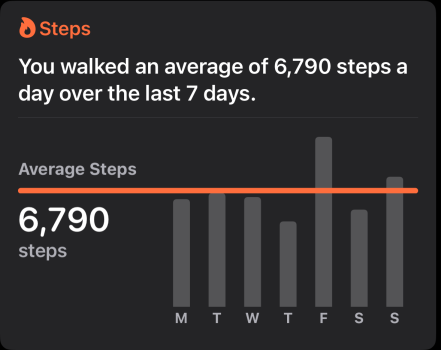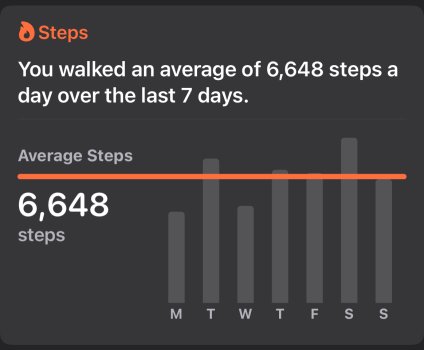Got a tip for us?
Let us know
Become a MacRumors Supporter for $50/year with no ads, ability to filter front page stories, and private forums.
Weekly Steps Total?
- Thread starter Julien
- Start date
- Sort by reaction score
You are using an out of date browser. It may not display this or other websites correctly.
You should upgrade or use an alternative browser.
You should upgrade or use an alternative browser.
I’m not on the latest version. I’m on 4.3.2.Where do you see the above? Since the last updates mine doesn’t show it anymore?
This is a fraction of what I used to do when I wasn’t on dialysis, but I keep as active as I can. I’m only using #steps as a metric to see how good my treatment is going and to make a decision on any given day whether to have standard Haemodialysis or BBM Haemodialysis (variable rate HD, where the computer determines what rate it can pull fluid off of you; rate goes up if you can safely pull off more fluid (ml)/ hour and dynamically adjusts downward as appropriate. In effect the dialyzer computer monitors your hydration state continuously. When I worked, I would deliberately park my car about 2 miles away from my lab. That plus working on my feet all day, I would easily get over 25,000 steps/day. Now on medical retirement, not so much. But as long as I can keep walking, I’ll keep walking. Even if it is only 6,000 steps/day.

Special bonus pic visually describing what I’m talking about. Not every patient can withstand more aggressive fluid removal b/c of other vascular/cardio issues. They would have a lower targeted fluid removal rate. B/c I worked in renal Pharmacology and I ask a lot of questions, they allow me to press buttons and fiddle around on the controls as long as I don’t do certain things. The sudden change in the slope of the curve at ~ 2hr 50m is a good indication that the maximum amount of fluid that can be removed without adverse effects (low blood pressure, sweating, ringing in the ears, nausea) is approaching or getting close. If the curve falls into the red zone, I’m usually feeling icky.
That’s why I usually bring a coffee or Red Bull with me into dialysis > for quick hydration, and to avoid going into caffeine withdrawal (all the caffeine circulating is stripped out w/in 15-20 minutes > garanteed headache). Oddly enough, Red Bull is safe b/c no Phosphoric Acid.

Tom

Special bonus pic visually describing what I’m talking about. Not every patient can withstand more aggressive fluid removal b/c of other vascular/cardio issues. They would have a lower targeted fluid removal rate. B/c I worked in renal Pharmacology and I ask a lot of questions, they allow me to press buttons and fiddle around on the controls as long as I don’t do certain things. The sudden change in the slope of the curve at ~ 2hr 50m is a good indication that the maximum amount of fluid that can be removed without adverse effects (low blood pressure, sweating, ringing in the ears, nausea) is approaching or getting close. If the curve falls into the red zone, I’m usually feeling icky.
That’s why I usually bring a coffee or Red Bull with me into dialysis > for quick hydration, and to avoid going into caffeine withdrawal (all the caffeine circulating is stripped out w/in 15-20 minutes > garanteed headache). Oddly enough, Red Bull is safe b/c no Phosphoric Acid.

Tom
Last edited:
Went hiking today near my house to find the multiple worked out gold mines. Forgot to start the workout/mapping button on Steps - Activity Tracker, but I did find honest to God quicksand mud, stuck up to my left knee, had a panic attack, fell over to my right, ruined a brand new parka and pulled myself out - but it was a good workout. So, victory.

Tom
Found out not to go hiking in a swampy area and to avoid the rest until the ground is dry. But I want to be able to walk as far as the river so I can pan for gold. The abandoned rail track way stretches for miles (or kiolmeters) and is public access land. To the right is the highway and my house. To the left is dense old growth forest, much more swamp and probably hibernating bears. And yes, people go quadding here. Not in this melting weather though.
edit: Colour me stupid but I always though that quicksand was a fictitious invention of the movies. It's not something I ever encountered while living on the prairies my whole life and now I find it 1/2 km from my house in Nova Scotia. Swamps too, though I knew they were real. Threw my rubberized winter boots in the garbage b/c they smell like poop.

Tom
Found out not to go hiking in a swampy area and to avoid the rest until the ground is dry. But I want to be able to walk as far as the river so I can pan for gold. The abandoned rail track way stretches for miles (or kiolmeters) and is public access land. To the right is the highway and my house. To the left is dense old growth forest, much more swamp and probably hibernating bears. And yes, people go quadding here. Not in this melting weather though.
edit: Colour me stupid but I always though that quicksand was a fictitious invention of the movies. It's not something I ever encountered while living on the prairies my whole life and now I find it 1/2 km from my house in Nova Scotia. Swamps too, though I knew they were real. Threw my rubberized winter boots in the garbage b/c they smell like poop.
Last edited:
Back to London and a massive drop in steps to my lowest for years (I’m overtired):

Register on MacRumors! This sidebar will go away, and you'll see fewer ads.



